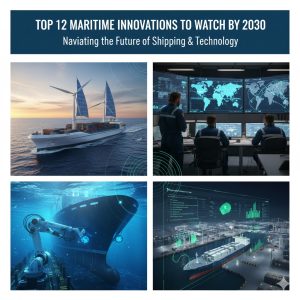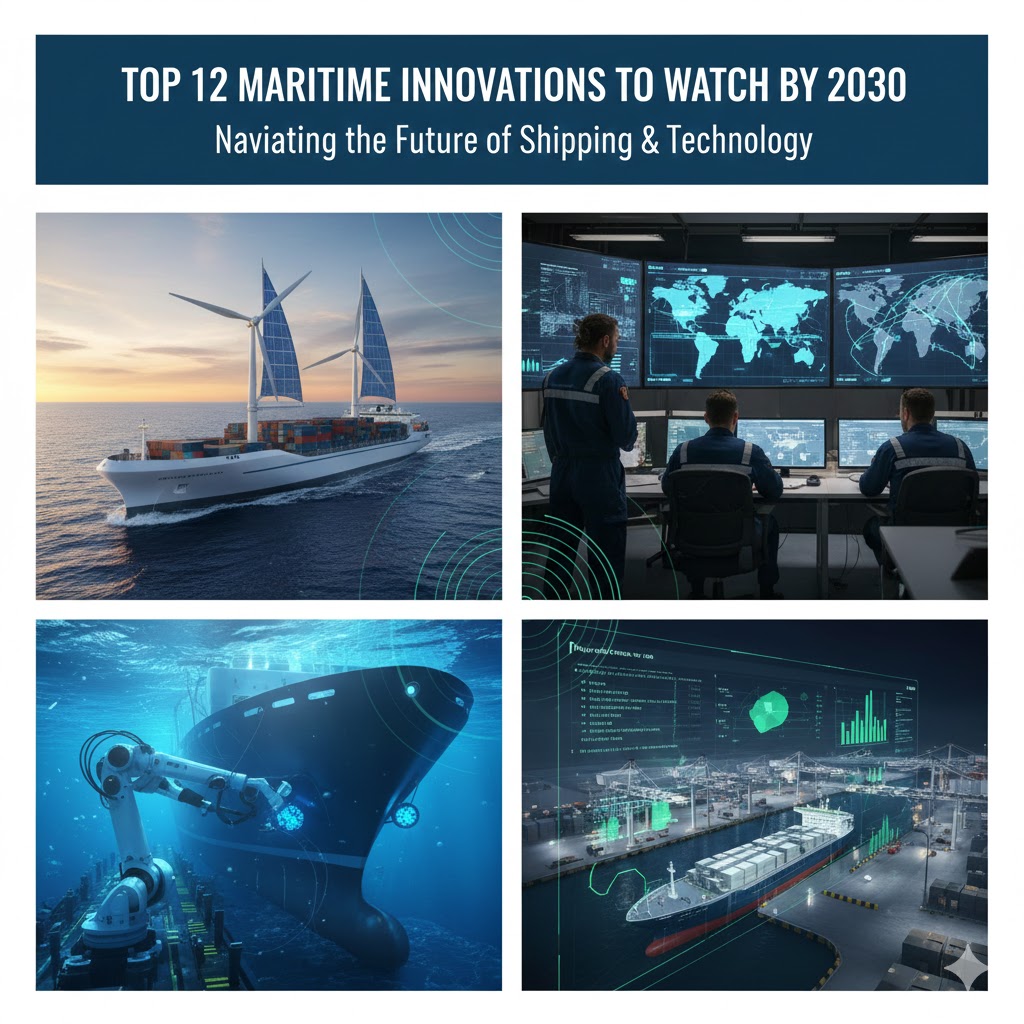
Discover the top 12 maritime innovations set to transform global shipping by 2030. From green fuels and AI-driven smart ports to carbon capture and autonomous ships, explore the technologies shaping the future of the maritime industry.
A Sea Change on the Horizon 🌊
The maritime industry, responsible for moving over 80% of global trade (UNCTAD, 2023), is standing at the edge of its greatest transformation in over a century. From the age of sails to the dominance of diesel engines, shipping has always been shaped by innovation. Yet the next decade may prove the most disruptive of all.
By 2030, shipping must balance efficiency, safety, and sustainability under the pressure of stricter international regulations, climate change, digitalisation, and geopolitical shifts. The IMO’s GHG reduction strategy is driving the sector toward net-zero by 2050, forcing industry players to rethink everything from fuels to ship design.
This article explores the 12 most promising maritime innovations that will shape the future of global shipping by 2030—technologies that are not just futuristic concepts, but already emerging in shipyards, ports, and research labs worldwide.
Why Maritime Innovations Matter in the 21st Century
Shipping is the lifeblood of global commerce. But it also faces unprecedented challenges:
- Decarbonisation pressures – Shipping contributes about 3% of global CO₂ emissions, and decarbonisation is no longer optional (IMO, 2023).
- Digital transformation – Data, AI, and automation are reshaping efficiency, safety, and security.
- Resilient supply chains – Ports and shipping lines must adapt to pandemics, wars, and climate impacts.
- Crew welfare & skills gaps – As technology advances, training and safety standards must evolve.
Each innovation discussed here represents a response to these pressures, blending technology, policy, and human adaptation.
–
The Top 12 Maritime Innovations to Watch by 2030
1. Alternative Green Fuels: Methanol, Ammonia, Hydrogen, and Beyond
The fuel transition is arguably the most disruptive change in maritime history. By 2030, many ships may no longer rely on heavy fuel oil (HFO) but instead on methanol, ammonia, LNG, hydrogen, and even biofuels.
-
Methanol is gaining traction: Maersk launched its first methanol-powered containership in 2023, with more on order.
-
Ammonia offers carbon-free combustion but poses toxicity challenges. Engine makers like MAN Energy Solutions are testing ammonia-fuelled engines.
-
Hydrogen is promising for short-sea shipping, with Norway already piloting hydrogen ferries.
These fuels are supported by EU “FuelEU Maritime” regulations and IMO’s GHG targets, making them more than experimental—they are essential.
2. Carbon Capture and Storage (CCS) on Ships
Even with alternative fuels, fossil fuels will remain part of the energy mix for years. Onboard carbon capture is emerging as a bridging solution.
-
Calcium Looping (CaL) and amine-based scrubbers are being tested on bulk carriers.
-
Pilot projects by DNV, Wärtsilä, and Shell show CCS can reduce emissions by up to 90%.
-
The challenge lies in storage and offloading infrastructure—can ports handle captured CO₂?
By 2030, hybrid systems (fuel + CCS) may become a standard compliance option.
3. Autonomous Ships and Smart Navigation
From crewed vessels with advanced autopilots to fully unmanned ships, autonomy is advancing rapidly.
-
The Yara Birkeland, the world’s first fully electric autonomous container ship, launched operations in Norway in 2021.
-
IMO is developing a regulatory framework for Maritime Autonomous Surface Ships (MASS).
-
AI navigation systems can already reduce collisions, optimise routes, and cut fuel use.
By 2030, we may see remote-controlled shipping corridors in Northern Europe and Asia.
4. Smart Ports and Digitalisation
Ports are racing to become data-driven logistics hubs.
-
The Port of Rotterdam uses AI and digital twins to simulate operations.
-
Singapore’s Tuas Mega Port integrates automation, drones, and AI for container handling.
-
Blockchain technology is improving cargo transparency and reducing fraud.
Smart ports not only improve efficiency but also enhance resilience against supply chain shocks.
5. Digital Twins for Ships and Ports
Digital twins—virtual replicas of ships or port facilities—are transforming maintenance and planning.
-
Wärtsilä, DNV, and Kongsberg are pioneering ship digital twins for predictive maintenance.
-
Digital twins can model fuel efficiency, weather routing, and even emissions scenarios.
-
For ports, twins simulate congestion, energy use, and climate resilience.
By 2030, nearly every new ship may come with a digital twin embedded in its design.
6. Advanced Hull Designs and Air Lubrication
Reducing friction means reducing fuel.
-
Air lubrication systems (ALS), pioneered by Silverstream Technologies, create a layer of bubbles under the hull, cutting drag by 5–10%.
-
Biomimicry-inspired coatings mimic shark skin to reduce biofouling.
-
Flexible hull materials may self-heal against corrosion.
Such innovations can save millions in fuel costs annually.
7. Wind-Assisted Propulsion: The Return of Sails ⛵
Ironically, shipping’s future may look a lot like its past—with wind power making a comeback.
-
Rotor sails (Flettner rotors) are already installed on tankers and bulkers, reducing fuel consumption by up to 20%.
-
Companies like BAR Technologies are designing rigid wing sails.
-
Hybrid “sail + engine” designs are gaining acceptance among shipowners.
By 2030, wind-assist could be standard for long-haul bulk and tanker shipping.
8. Energy Storage and Hybrid Propulsion
Batteries are not just for cars.
-
Norway’s ferries already use large-scale marine batteries.
-
Hybrid propulsion (batteries + engines) enables fuel savings during manoeuvres and port stays.
-
Supercapacitors and future solid-state batteries could extend range.
Energy storage will be essential for short-sea shipping and emission control areas (ECAs).
9. Maritime Cybersecurity
As ships digitalise, they also become more vulnerable.
-
The 2017 Maersk cyberattack cost $300 million in damages.
-
IMO now requires cyber risk management as part of the ISM Code.
-
Solutions include blockchain cargo tracking, encrypted navigation data, and AI anomaly detection.
Cybersecurity is not just an IT issue—it’s now a core safety concern at sea.
10. Crew Training and Simulation with VR/AR
Technology cannot replace humans, but it can make them better prepared.
-
VR simulators replicate complex tanker discharges or engine failures for safe training.
-
AR headsets can guide engineers through maintenance step-by-step.
-
Seafarer training institutions are adopting gamified digital learning platforms.
By 2030, most maritime academies will blend VR/AR with real-world sea time.
11. Circular Ship Recycling and Eco-Design
Sustainability is not just about operations—it’s about the ship’s entire life cycle.
-
The Hong Kong Convention on Ship Recycling (expected to enter into force by late 2020s) will tighten standards.
-
Shipbuilders are exploring modular eco-designs for easier recycling.
-
Green steel from recycled ships may feed back into new vessel construction.
Circularity is set to become an industry standard.
12. Ocean Data, AI, and Climate Services
Finally, the shipping industry is learning to harness ocean data at scale.
-
AI weather routing can cut fuel consumption by up to 10%.
-
Projects like Copernicus Marine Service provide open climate data.
-
Ocean sensors on commercial ships contribute to global climate models.
By 2030, every ship may double as a mobile ocean observatory, contributing to science while trading.
Challenges and Possible Solutions
-
High Costs – Many innovations require billions in investment. Solution: Green financing, carbon pricing, and public–private partnerships.
-
Regulatory Gaps – IMO frameworks are evolving slowly. Solution: Faster regional initiatives (EU Fit-for-55, FuelEU Maritime).
-
Safety Risks – New fuels like ammonia pose hazards. Solution: Updated training (STCW amendments) and class society guidelines.
-
Global Inequality – Developing countries may lag in adopting innovations. Solution: Knowledge transfer and international cooperation.
Real-World Case Studies
-
Maersk Methanol Fleet: 25+ methanol-fuelled containerships ordered by 2027.
-
Silverstream’s Air Lubrication: Installed on LNG carriers, saving thousands of tonnes of fuel.
-
Yara Birkeland: Fully electric autonomous ship, reducing emissions in Norway.
-
Port of Singapore: Tuas Mega Port integrating AI and automation, aiming to be world’s largest by 2040.
FAQs
1. Will autonomous ships replace seafarers by 2030?
Not entirely. Crews will remain essential, but roles will shift towards remote operations and technical oversight.
2. Which alternative fuel is most promising?
Methanol is leading now, but ammonia and hydrogen could dominate by 2030, depending on scalability and safety solutions.
3. What is the biggest barrier to maritime decarbonisation?
Infrastructure for new fuels and CCS systems—ports must adapt alongside ships.
4. How will digital twins improve shipping?
They allow predictive maintenance, fuel optimisation, and faster regulatory compliance through virtual testing.
5. Are wind-powered ships realistic in modern trade?
Yes. With hybrid rotor sails, large vessels can save up to 20% fuel without sacrificing reliability.
6. How is cybersecurity relevant to shipping?
Modern ships are floating data centers; protecting navigation, cargo, and crew safety from cyber threats is critical.
7. Will shipping still be affordable with all these changes?
Costs may rise initially, but efficiency gains and economies of scale should stabilise freight rates.
Conclusion: Setting Sail Towards 2030 🚢
The future of maritime transport is neither purely digital nor purely green—it is a fusion of technologies, policies, and human adaptation. By 2030, ships will likely be cleaner, smarter, and safer than ever before.
For seafarers, this means new training and skills. For shipowners, major investment decisions. And for society, it means a global trade system that is more resilient, sustainable, and transparent.
Innovation at sea has always been about survival. Today, it is about survival and sustainability—a new compass guiding shipping into the future.

